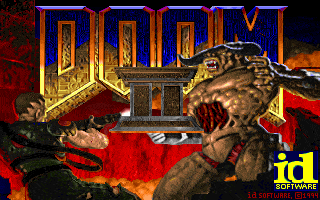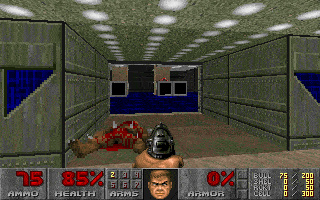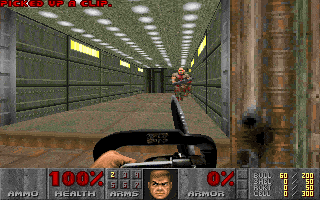Doom II (1994-)
Doom II: Hell on Earth was developed by id Software and released in 1994, with GT Interactive serving as its publisher. It was the direct sequel to the hugely influential Doom (1993) and continued the fast-paced, first-person shooter action that had revolutionized the genre. The game placed players once again in the role of the Doomguy, tasked with battling hordes of demons unleashed on Earth following the events of the original game. The dark sci-fi horror theme, combined with intense combat, set a new standard for action games in the 1990s.
Initially launched for MS-DOS, Doom II was later ported to numerous platforms, including the PlayStation, Mac OS, and more recently to modern consoles and PCs via re-releases and remasters. The gameplay retained the core mechanics of the original Doom, featuring fast movement, a variety of weapons, and maze-like levels filled with enemies and secret areas. Doom II introduced new enemy types and the iconic Super Shotgun weapon, adding fresh tactical options for players. The level design was noted for being larger and more complex, increasing the challenge and depth of exploration.
The soundtrack of Doom II was composed by Bobby Prince and featured a heavy metal and industrial rock-inspired score that perfectly complemented the game’s dark and aggressive atmosphere. The music dynamically matched the on-screen action, amplifying the tension during combat and immersing players in the nightmarish world. Sound effects such as weapon fire, monster growls, and environmental noises contributed to the visceral experience that became a hallmark of the series.
Promotion for Doom II leveraged the massive success of its predecessor, with strong anticipation building among fans and the gaming press. The game was widely covered in magazines and gaming events, praised for its enhanced graphics, new enemies, and expanded gameplay. Upon release, Doom II received critical acclaim for refining the formula of the original while introducing enough new content to satisfy returning players. It solidified the Doom franchise as a pioneer in first-person shooters and influenced countless games that followed, with sequels like Doom 3 and the 2016 reboot continuing the legacy.
Images from MobyGames
Buy Doom II
Click one of the Ebay or Amazon buttons below to check the latest prices and purchase Doom II for that particular platform.



Related Searches
Doom II is available to purchase and download from a range of vendors. Always shop around...
Doom II may be available to download as abandonware from one of the many sites that offer this. Search now....
There are various sites out there that can offer cheat codes for games. Search now to find all available...
There are many sites out there that have collated and documented historic reviews of this game. Search now...
We don't host or link to rom sites for this game. However, there are many sites out there that may be...
The initial release date for Doom II is stated as 10th October 1994. Other ports of the game may have been....
Doom II is available to purchase and download from the link(s) shown further up this page....
There are multiple sites around the internet that offer visual guides to this game. Search now to find the....









